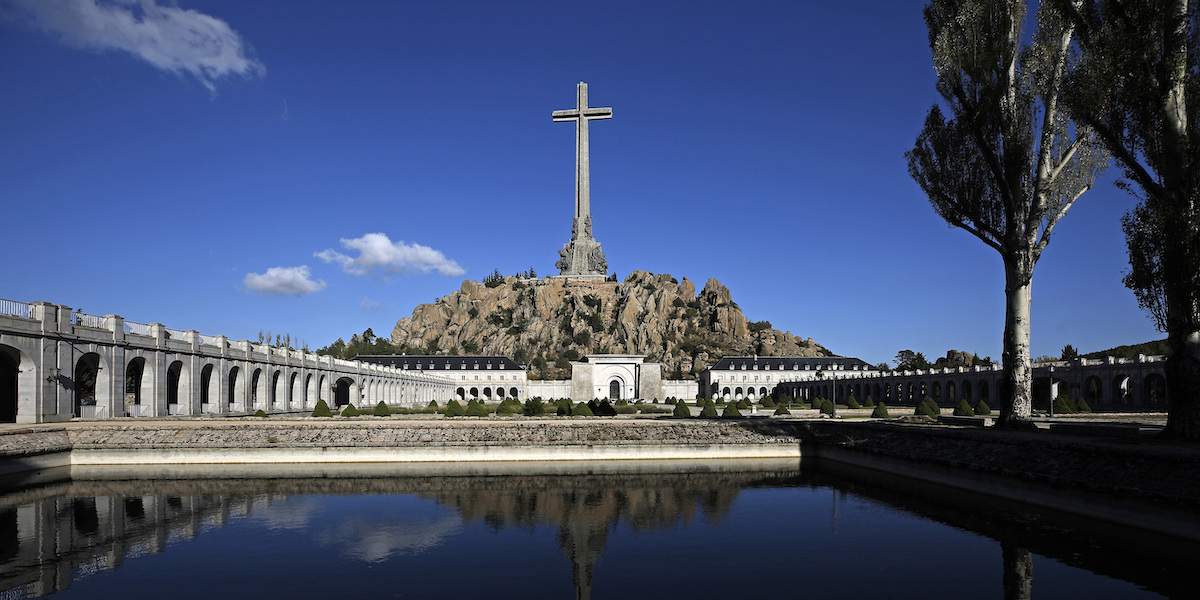The Spanish government on Monday he announced the beginning of the exhumation operations of 128 bodies of people who died during the Spanish Civil War and buried in the monumental complex of Valle de los Caídos (Valley of the Fallen), about fifty kilometers from Madrid, built in 1959 by the Franco regime. Up until four years ago, the dictator Francisco Franco himself was buried in the complex and the exhumation of the bodies, long requested by the relatives of the buried people, is the latest development of a story that has been at the center of a broader debate for years on how whether or not Spain has come to terms with its Francoist past.
Franco, a royalist general, established a nationalist and fascist dictatorship in 1939, at the end of a civil war he won against the forces of the left, which lasted until his death in 1975. Around 34,000 were buried in the monumental complex of Valle de los Caídos people, many of whom were killed during the Spanish Civil War and during the repression of the regime in the following years. When the complex was inaugurated in 1959, the regime presented it as a symbol of national reconciliation and transfer the remains, at that time buried in other parts of Spain, also of those who had fought against Franco.
In fact, the Valle de los Caídos complex, built in part by political prisoners of forced labour, is deeply divisive and considered by many to be a celebration of Franco’s regime. Also because it has become a pilgrimage destination for thousands of nostalgic supporters of the regime, who for decades have visited the tomb of Franco himself making, among other things, the fascist salute.
A great many of the bodies of people who died in the civil war or killed in the reprisals of the regime were buried mass graves, buried anonymously and never identified. This situation has created suffering, indignation and a big debate, also because for decades Franco and thousands of people who died fighting against him were buried in the same place, a monument celebrating the regime. Over time, the families of the victims, politicians, scholars and human rights experts have intervened on the matter, asking for the state to intervene.
Finally, four years ago, Franco’s body was transferred to a private and less celebratory place on a proposal from the socialist government of Pedro Sánchez, amid much opposition. The exhumation and identification of the first 128 bodies represents a further step towards what many pundits and historians believe is a greater awareness of the country about its Francoist past, a process that still encounters some resistance in part of Spain’s Catholic and conservative ruling class . The fact that thousands and thousands of victims of the regime have never been identified, despite being in such an important complex, is in fact considered a clear example of how Spanish society is in many ways refractory to come to terms with the period of the dictatorship .
The exhumation of the bodies will involve a multidisciplinary team of 15 specialists including coroners, archaeologists, dentists, geneticists and members of the scientific police. In the first phase of the operation, 18 bodies placed in a specific crypt of the mausoleum will be exhumed and identified, and then we will proceed with the others. The country writes that a kind of laboratory was set up inside the monumental complex to allow the experts to carry out some analyzes with an X-ray machine, some microscopes, various measuring instruments, large tables and a special lighting system. Part of the exhumed remains will also be sent to the National Institute of Toxicology and Forensic Sciences in Madrid.
The process of identifying the bodies could take weeks or even months: it is therefore likely that the results will be published after the next elections, scheduled for the end of July. Also for this reason, the operation will probably be one of the issues discussed during the electoral campaign: the law that allowed it had been introduced precisely by the Sánchez government last October. Alberto Núñez Feijóo, the main opponent of Sánchez candidate with the Popular Party (PP), has promised to revoke the law if elected. The centre-right PP was also founded in 1989 by conservative politicians who had had links with Francoism and who over the years have maintained an at times ambiguous attitude towards the regime.
As happened with the exhumation and relocation of Franco’s grave in October 2019, the current exhumation has also been opposed in various ways. Groups of nostalgics for the regime and politicians from the PP opposed it. Among others, Carlota López Esteban, the mayor of San Lorenzo de El Escorial, the municipality in which the complex is located, which was rejected to authorize the operations, in an affair that ended last March with the rejection of the last appeal against the start of the works by the Spanish Supreme Court.
– Read also: What to do with the body of a dictator
